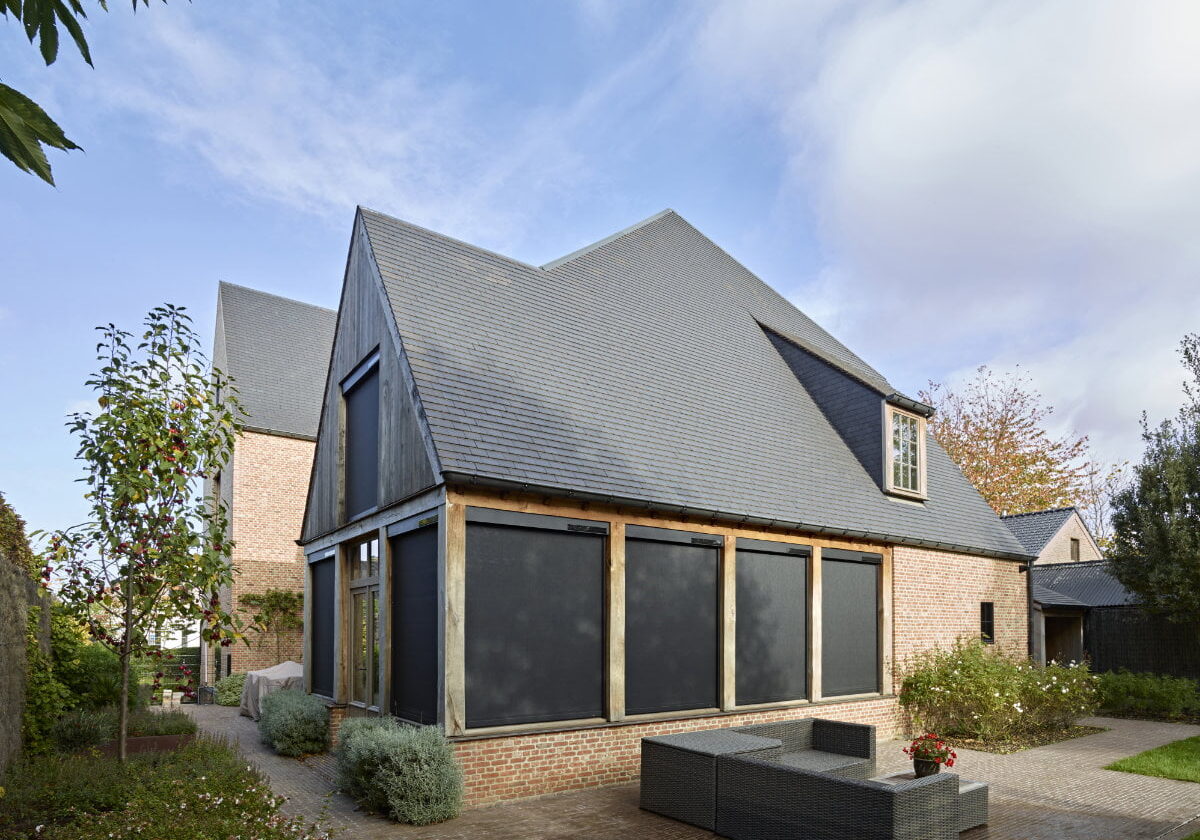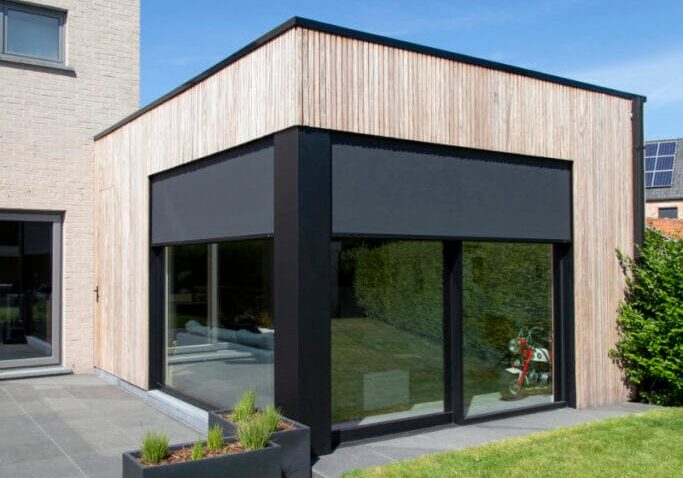Comparing External and Internal Blinds: Which Is Better?

It's a question that comes up in many homeowners' minds; should I choose interior blinds or exterior blinds? Is one better than the other? What's the difference?
Exterior blinds are primarily designed to keep your home cool by preventing heat from travelling through glass. Heat gain has become a more significant problem in recent times for two reasons; the trend for large windows, doors and rooflights to increase natural light in the home, and warming temperatures due to climate change. Popular in Europe for many years, they are just beginning to gain traction in the UK.
Interior blinds have been used in the UK for decades, primarily to provide light control, shading and help prevent heat loss in winter. Available in a wide range of designs and fabric types, they are a versatile shading solutions for most homes.
It's important to remember that you don't have to choose between internal and external blinds; many homeowners choose to have both. Dive into the world of shading solutions as we explore the distinct benefits and drawbacks of exterior and interior blinds, helping you decide which is the better choice for your situation.
Effectiveness in Energy Efficiency and Heat Control
Exterior blinds are highly effective in reducing heat gain as they block sunlight before it enters the home, making them a sustainable alternative to air conditioning. By providing shade and reflecting heat, they can significantly reduce indoor temperatures, especially in areas with large glazing. A 2020 study by the Pacific Northwest Labs in Oregon, USA found that exterior blinds could reduce indoor temperatures by 5 degrees compared to a control home with no shading.
Interior blinds contribute to energy efficiency by retaining heat inside during colder months; research by the University of Salford has demonstrated that interior blinds and shutters can reduce heat loss through windows by between 13% and 33%. However, they are less effective at preventing heat gain in the summer, as the heat has already entered through the glass before being partially blocked or reflected by the blinds.
The choice between external and internal blinds for energy efficiency and heat control can depend on the climate and the specific needs of the household. Exterior blinds excel in warmer climates by preventing heat from entering, while interior blinds are beneficial in cooler climates by helping to keep heat inside. However, overheating in homes is becoming more of a problem even in cooler climates like the UK due to the warming temperatures caused by climate change, making exterior blinds an increasingly popular passive cooling strategy.
Impact on Natural Light and External Views
Exterior blinds allow homeowners to maintain their view of the outside even when the blinds are down, preserving natural light and visual connection with the environment. Many external blind fabrics are designed to offer transparency while still providing shade. In contrast, interior blinds can vary in their ability to allow natural light and views.
Some interior blinds, such as sheer fabrics, can provide privacy while still letting in light and allowing limited visibility of the outside. However, they might not be as effective in blocking heat or providing full privacy as some exterior solutions.
Choosing between exterior and interior blinds in terms of light and views will often come down to personal preferences and the importance of maintaining visibility versus the need for privacy and light control.
Cost Analysis: Initial Investment vs. Long-term Savings
While exterior blinds can be quite expensive, they offer significant long-term savings by reducing the reliance on air conditioning and lowering energy bills. The initial investment may be higher for exterior blinds, but the cost can be offset over time through energy savings.
Interior blinds are generally less expensive and can be a cost-effective way to improve energy efficiency, particularly when it comes to retaining heat in the winter. However, they are not likely to provide the same level of energy savings during the summer months as exterior blinds.
Ultimately, when considering the cost, it's important to weigh the initial outlay against the potential energy savings and increased comfort levels that both types of blinds can offer over the lifespan of the product.
Flexibility and Aesthetic Appeal: Color and Motorization Options
Both exterior and interior blinds come in a wide variety of colors and finishes, which allows homeowners to choose options that complement their home's aesthetic. Motorisation and connection to home automation are available for both types, enabling easy control with the touch of a button or through smart home systems. This convenience factor can be a significant consideration for those looking to integrate blinds with their home automation systems.
The choice between exterior and interior blinds in terms of aesthetic appeal will largely rest on the desired look and functionality. Those seeking a sleek, modern exterior may prefer the clean lines of exterior blinds, while those looking to add interior design flair might opt for the diverse patterns and styles available in interior blinds.
Practical Considerations: Installation and Maintenance
Exterior blinds typically require fitting by a trained installer due to their complexity and the need for secure attachment to the building's exterior. This can add to the overall cost but ensures that the blinds are installed correctly and function as intended. Interior blinds, on the other hand, often offer the convenience of DIY installation, making them a more accessible option for those who are handy and looking to save on installation costs.
Maintenance for both types of blinds will vary depending on the material and mechanisms involved. Exterior blinds are designed to perform in and withstand harsh environmental conditions, so should not require much cleaning or maintenance to keep them functioning properly and looking good. Interior blinds are also generally easy to maintain, as they are protected from the elements, but they still require regular cleaning and occasional repairs, depending on usage and quality.
Is One Type Of Blinds Better Than The Other?
In conclusion, when choosing between exterior and interior blinds for your home, it's essential to consider what you want the blinds to achieve. Factors such as energy efficiency, natural light, cost, aesthetic appeal will all be part of your considerations. Each type of blind is suited for a particular function, whether that is preventing heat gain and increasing comfort, or providing light control and a stylish feature in a room.
We actually recommend installing exterior and interior blinds to enjoy the benefits both offer. For example, you may want to install external blinds on the windows that receive the most sunlight to minimise heat gain, but fit internal blinds on the remaining windows in the house for light control.
Both types provide options for enhancing your home's style and comfort through color choices, motorization, and temperature control. By weighing these factors and understanding your specific needs, you can make an informed decision that suits your lifestyle and enhances the comfort and functionality of your living space.



